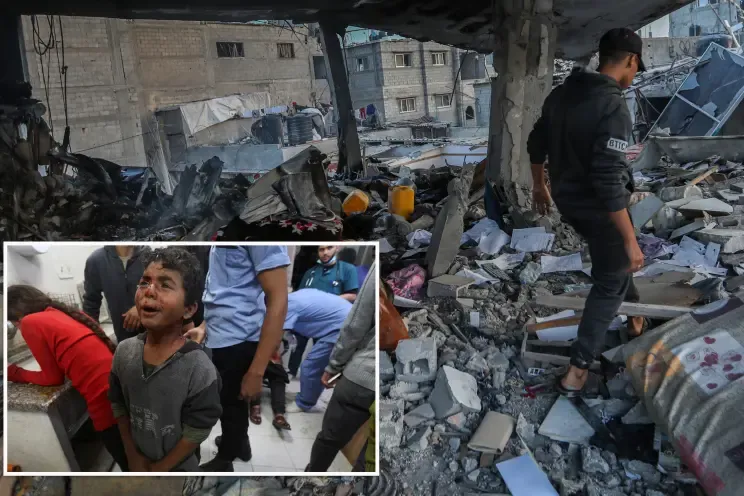(New York Post) With Israel and Hamas returning to arms Friday after the terror group ended a weeklong pause in the fighting across the Gaza Strip, the Jewish state is again under international pressure to halt its war to eliminate the jihadists who brutally slaughtered more than 1,200 people — including 33 Americans — on Oct. 7.
But how, exactly, can the Israel Defense Forces avoid harming civilians when its enemy hides behind innocents, directing its operations from the most sacred of safe spaces – including hospitals – in violation of the international rules of war?
“[Hamas’] M.O. is deliberately to use the civilian realm for their own human shield protection in the most cynical ways,” IDF Lt. Col. Amnon Shefler told reporters at the Israeli embassy in Washington this week.
“I can show you endless amounts of pictures and videos of how rockets are being manufactured in schools, hosted in schools, shot from schools, mosques and homes. We’ve found rockets and ammunition underneath baby girls’ beds and also in hospitals, sadly,” he added.
National Security Council spokesman John Kirby emphasized Hamas’ apparent lack of care for Palestinian civilians Friday, noting that by declining to release further hostages, they stopped humanitarian aid from getting into Gaza.
“The people who suffer the most because of that are the people of Gaza, the Palestinian people,” he said. “So if Hamas truly – as they claim to – do care about Palestinians, they’ll do what they can to come up with a list of hostages that can be exchanged, so that that aid can continue to flow.”
A Palestinian man inspecting damage after Israeli air strikes in Khan Yunis in the Gaza Strip on Dec. 3, 2023. Photo by Ahmad Hasaballah/Getty Images
An unfair fight
Secretary of State Antony Blinken demanded Thursday that Israel not the restart the fighting until it established a “clear plan” to avoid civilian harm – and threatened to withdraw support should it not comply with “humanitarian law.”
But hours later, Hamas terrorists opened fire at a Jerusalem bus stop, killing three civilians and Blinken’s aspirations in one fell swoop.
Despite accusations that Israel’s forces have caused the deaths of thousands of Gazans in the nearly two-month-old war, Shefler said the IDF is “the leading military in the world” at fighting in dense, urban environments while minimizing civilian casualties.
A Palestinian boy crying after being brought to Nasser hospital after an air strike on Dec. 3, 2023. REUTERS/Ibraheem Abu Mustafa
“For years, we’ve been building capabilities, first out of necessity, and on top of that, because that’s what we believe in,” he said. “That in fighting these kinds of complicated battles, we need to find the best ways to stand up for morals and to our values, and also to the Law of Armed Conflict.”
The problem, however, is that when only one side abides by international conflict standards – or cares about saving civilian lives at all – the law itself can become a handicap.
“It was probably written in many ways [to support moral fighting], but it was not written to deal with these kinds of circumstances – dealing with terrorist organizations,” Shefler said. “That’s why we’re finding ourselves in a very, very complicated space of a war zone with a deeply embedded terrorist organization within all this [civilian] infrastructure and underneath the ground.”
Footage of the Oct. 7 attack reviewed by The Post shows Hamas terrorists slaughtering children, beheading the dead and encouraging each other to “play with” the bodies.
Palestinians gathered at a crater in Rafah after an Israeli strike in Gaza on Dec. 3, 2023. Photo by SAID KHATIB/AFP via Getty Images
But the terror did not end there. Until the fighting briefly stopped Nov. 24, Shefler said Hamas was “firing more than 10,500 rockets at Israeli civilians, schools, hospitals, at religious institutions” in Israel each day.
“They did everything that they can with the aim to kill as many civilians as possible,” he said.
Mitigating harm by assuming risk
The terror group’s war-crime strategy makes it nearly impossible for Israel to defend itself without more casualties. But that doesn’t mean they don’t try to avert losses.
“How does one deal with a terrorist infrastructure that is underneath the hospital? We can strike it from the air, but of course that has its implications – and that’s why we chose not to do it,” Shefler said.
The military leader also detailed multiple other creative strategies the IDF uses to mitigate harm to Gazans – from technology use to more rudimentary tactics – putting its own soldiers at greater risk to do so.










